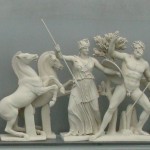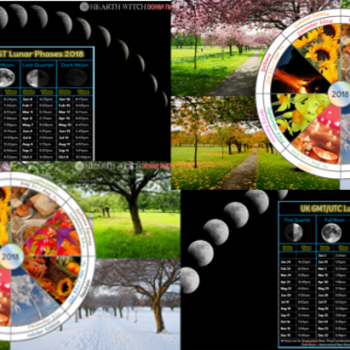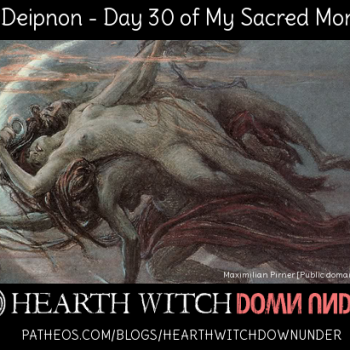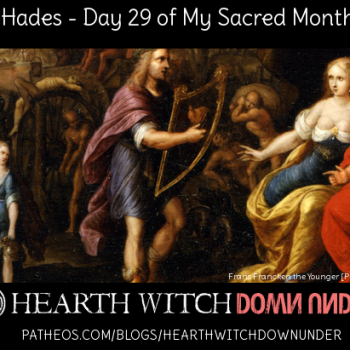
The Cardinal Points
So this one definitely doesn’t seem like a big deal, how can the cardinal points be different between the hemispheres? Well, obviously they are not. The directions remain the same, north is north is north. It’s not the directions, it’s the things that correspond with those directions that matter here.
One of the first witchy books I read as child stated the following,
North: Earth
East: Air
South: Fire
West: Water
I tried to follow that, I really did, but it just felt so very wrong to me. South is fire? South is freaking fire? What is that? South of me is Tasmania and ice. There is not fire down there! I was noping all over the place on this one. Now, back then I thought I had to “follow the rules” to be a good witch, so it didn’t occur to me for a while that I could just choose to create my own associations. Once I did let go of following the rules (which I was never that good at anyway, so it was a relief) I really let go of following the rules. And that deserves its own post really, how all of our witchy and Pagan correspondences and associations are not universal truths and some of them are somewhat arbitrary.
I live in Victoria, so I am right down the bottom of Australia and on the east. All of Southern Australia and Western Australia are to my west, mostly ocean to the east, Tasmania, ocean and ice to the south and New South Wales, Queensland, and some of Asia leading to the equator to my north. So this is the list I devised for myself.
North: Fire (equator)
East: Water (lots of ocean in that direction)
South: Air (it’s basically just ice down there)
West: Earth (a large portion of Aus is to my west, that is a lot of land)
Now, I must be clear, this is my list. Only mine. Others can use it, certainly, if you want to and it fits, then take away. However, it is not the only possibility – even for my specific area. Here I could easily swap north and west. North of me, as I have said, is NSW and QLD, which is a fair bit of land. West of me is WA, and if you go a bit north-west you have central Australia which is basically just the deadly heat of the desert. As such, I could easily say the North is Earth and West is Fire. Just as easily I can swap South and East, they both hold water and air. I chose Air for the south, because the majority of the water is frozen and I imagine the freezing air in my lungs. But it could easily be water south and air east.
For Aussies who live in Western Australia, it perhaps makes more sense to have Earth to the East, where the bulk of Australia is. But fire could go there to, that’s also the bulk of the desert – well, depending on where you live in WA that is. Wherever you go in Australia, you will have to determine the directions for each element based on your specific location. And this is true for every other place on this planet, north, south, east or west.
Thankfully that is all that needs to be figured out for this particular issue in this particular series – the rest of the correspondences for the elements can still be applied as normal. However I should note, the other correspondences (symbols, colours, etc) should be based on the element, not the direction. It makes no sense for the colour red to be associated with airy south or watery east, now does it?
And that’s it. 180 Degrees of Separation, done. The moon, the full moon names, the festivals and seasons, the elements and the direction to cast circle. Not a lot, in the intro post I said it would be 3 posts. And it has evolved into 6 – over 12,000 words in case you’re wondering, since each post reached over 2000 each (hence there being more posts than I had planned). I don’t mind admitting that I am glad this is done and I am heaving a sigh of relief right now. I enjoyed doing this series – but it kept growing so much that it seemed like I would be working on it forever.
This series hasn’t covered all of the differences of course. However, the other differences I can think of, that people ask about, are not really things that can be compared to the northern hemisphere, but must stand alone as things unique to Aussie Paganism. Things like our unique animals and plant life and even some of our unique national holidays and celebrations. Not only are they not comparable to the rest of the world – what can you compare koalas to after all – but there are way too many of them for me to cover in a short series.
This is not to say I won’t be looking into such things, I will actually, as and where I can. But anything I post on Aussie Paganism will be irregular and sporadic. It also won’t be strictly Paganism, but also me trying to adapt Hellenism to Australia, so it will serve a double purpose – and as such has absolutely no place in this specific series.
I really hope this series has been helpful to all of you reading along over the weeks, and I hope it wasn’t just helpful for Aussie, New Zealanders and other southerners, but also for those of you up north too. I know I couldn’t give definitive answers to all of the issues and questions posed by this series, but I hope that I least gave everyone a starting point on how to find the answers to fit your own individual needs.
Note, for just in case: A few times in this post I have said things like, “the sun moves right to left” – this should be translated as “the sun seems to move from right to left”.
Sources and Further Reading
Sunwise on Wiki
Widdershins on Wiki
Under the Waning Moon
Elements and Correspondences
Voces Magicae – This is a fantastic break down of the elements and the different ways they are used in different systems. I definitely suggest reading this one!
Australis Incognita – A great Aussie post on the directions and elements, by a member of the former Pagan Veil and one of my favourite Aussie bloggers. Includes more links to more great posts on the elements issue.

















